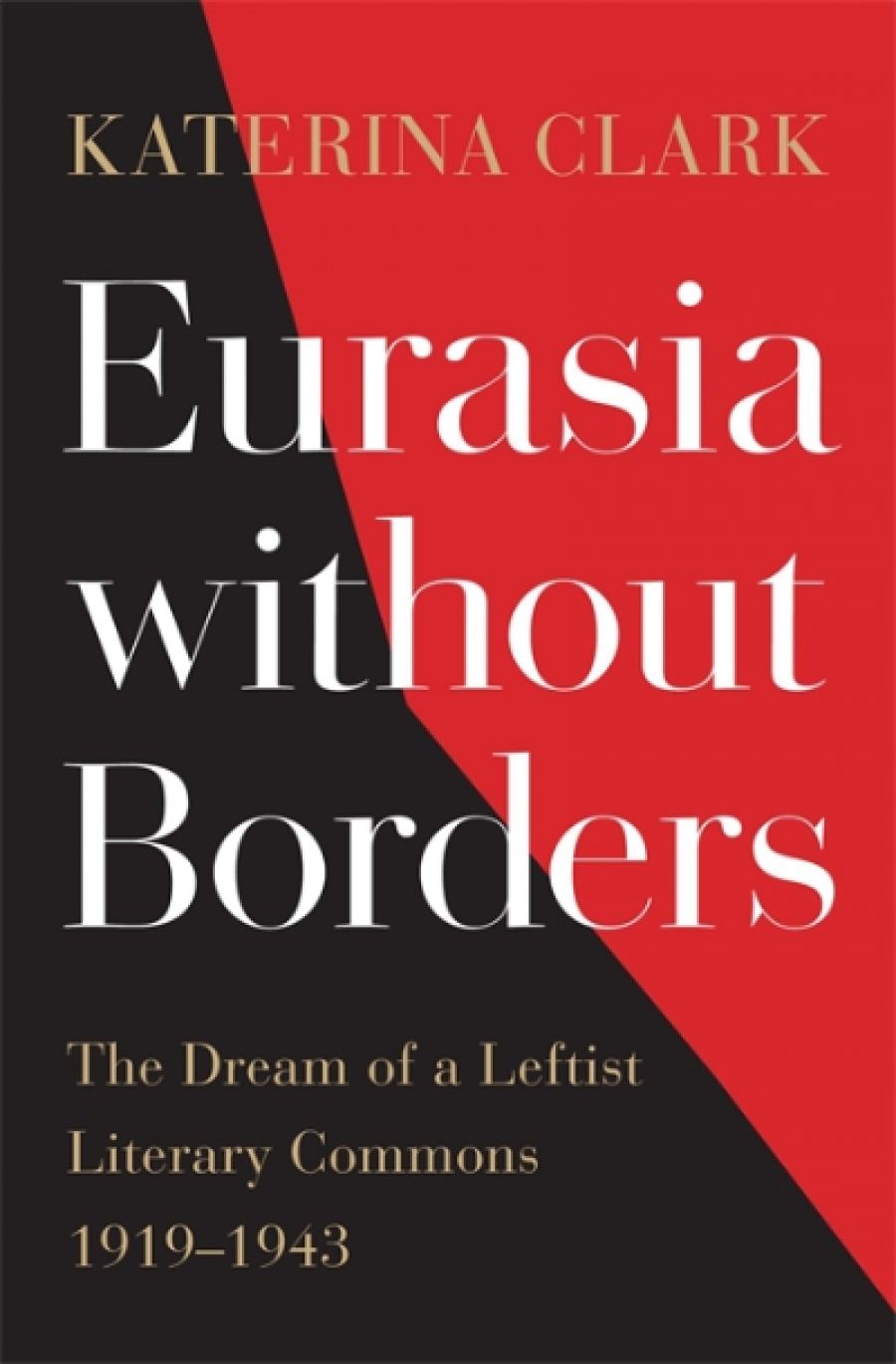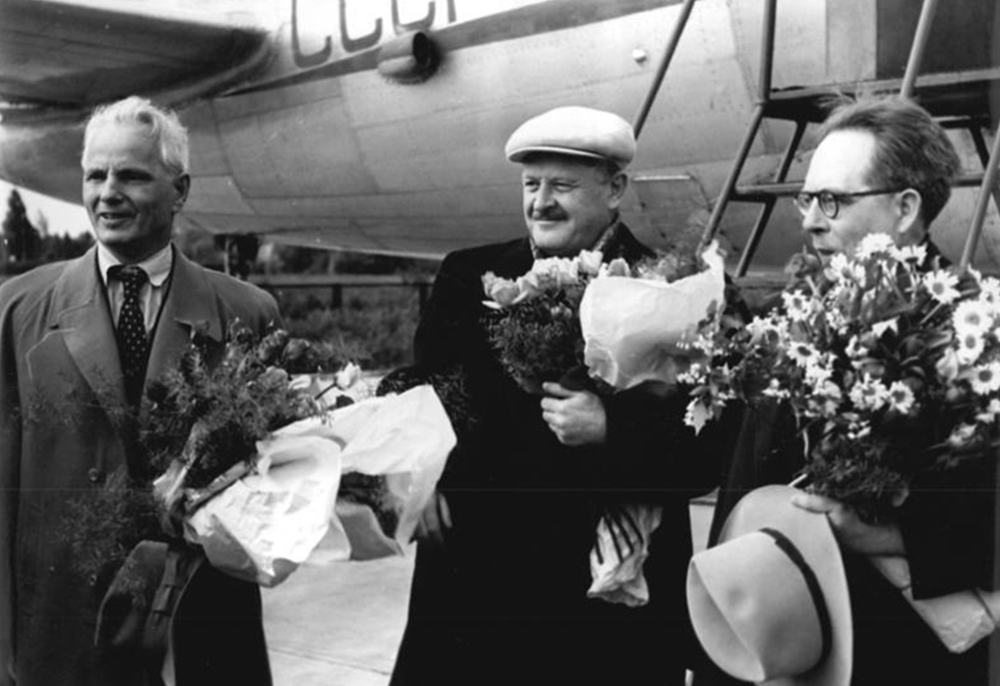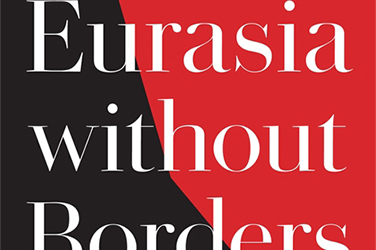
- Free Article: No
- Contents Category: Literary Studies
- Review Article: Yes
- Article Title: Eastward, ho!
- Article Subtitle: The dream of a red Eurasia
- Online Only: No
- Custom Highlight Text:
In the time before festivals, writers used to attend congresses to perform their role as ‘the unacknowledged legislators of the world’ in Shelley’s fine phrase. A who’s who of literary leftists and liberals gathered in Paris for the First International Congress of Writers for the Defense of Culture in 1935, in solidarity against the rise of fascism across Europe. Nettie Palmer was a member of the Australian delegation. She was pleased to spend time there with her younger compatriot Christina Stead, who was living in London. Both writers were internationalists, but at different points on a spectrum.
- Article Hero Image (920px wide):

- Article Hero Image Caption: Soviet writers in Berlin on 21 May 1952 to take part in the 3rd German Writers' Congress. From left to right: Stepan Stschipatschew, Nazim Hikmet and Prof. Myasnikov (photograph via Wikimedia Commons)
- Alt Tag (Article Hero Image): Soviet writers in Berlin on 21 May 1952 to take part in the 3rd German Writers' Congress. From left to right: Stepan Stschipatschew, Nazim Hikmet and Prof. Myasnikov (photograph via Wikimedia Commons)
- Featured Image (400px * 250px):

- Alt Tag (Featured Image): Nicholas Jose reviews 'Eurasia without Borders: The dream of a leftist literary commons 1919–1943' by Katerina Clark
- Book 1 Title: Eurasia without Borders
- Book 1 Subtitle: The dream of a leftist literary commons 1919–1943
- Book 1 Biblio: Harvard University Press, US$39.95 hb, 458 pp
- Book 1 Readings Link: booktopia.kh4ffx.net/5bBYML
Fox, who was killed in the Spanish Civil War the following year, reappears as an ‘idiosyncratic communist functionary’ whose ‘intellectual purview was Eurasia’, in Katerina Clark’s bold new study. ‘The call for a Eurasia without borders represents a much more radical gesture than the call to form a revolutionary Euro-pean culture, given that Eurasia’s two continents, Europe and Asia, have for centuries been regarded as absolutely, and irrevocably, separate,’ Clark begins, explaining how under the banner of Eurasia – chimerical, utopian, a zone rather than a geographical place – Soviet ideology projected new cultural possibilities.
The ‘Congress of the Toilers of the East’, at Baku, Azerbaijan in 1920, promulgated a ‘postnational political order’ in which literatures would ‘harmoniously intermingle … in a single common international ocean of poetry and knowledge’. That was despite the ‘post-Babelian variety of languages’ spoken at Baku, with Russian uncomfortably dominant, leaving many delegates unable to understand what was said. Language and translatability would always be problems.
Clark describes the cultural structures directed vertically from Moscow and the horizontal networks of ‘encounter and cross-fertilisation’ across the world that were not necessarily communist-affiliated. She proposes two overlapping models, a leftist ‘literary international’ on one hand and a more amorphous, self-selected ‘ecumene’. ‘A huge question for this book has been how to reconcile the call of the national with that of the international’, the cosmopolitan and the patriotic, she writes. She recognises the ‘non-fit’ of concepts from Euro-Russian culture with China, for example, even as activists linked Spain and Shanghai in the fight for democracy in 1936: ‘bookends that marked the parameters of Eurasia’.
Clark explains how under the banner of Eurasia – chimerical, utopian, a zone rather than a geographical place – Soviet ideology projected new cultural possibilities.
It’s a mighty tale that ventures well beyond the usual scope of world literature, and timely too. Eurasia is back if you hadn’t noticed. After they met at the Winter Olympics in Beijing last month, Vladimir Putin and Xi Jinping released a joint statement proclaiming the ‘no limits’ friendship of Russia and China and reaffirming ‘their focus on building the Greater Eurasian Partnership’.
As Professor of Comparative Literature and Slavic Languages and Literatures at Yale University, Clark commands an extraordinary breadth and depth of scholarship across languages. Her account is arranged artfully and with pedagogical thoughtfulness, moving forward and eastward from the idealistic early phase of literary internationalism in the 1920s to ‘the unravelling of the ecumene’ in the 1940s, with successive chapters on Turkey, Persia, Afghanistan, India, and China. The focus is on individuals who reveal the distinctive challenges each cultural arena presents, as political divisions intensify into war. There are far-flung networks and conflicting loyalties. W.H. Auden and Christopher Isherwood, in China when Nazi Germany invades Austria, ask themselves: ‘What does China matter to us in comparison to this?’
Among Clark’s fascinating cast of cultural intermediaries and fellow travellers is the poet Nâzim Hikmet, who stood with Vladimir Mayakovsky to chant poems in Turkish to avant-garde Moscow audiences, who heard only the boom of his voice. Hikmet’s poem about his Chinese friend Ėmi Xiao, The Gioconda and Si-Ya-U, imagines the Mona Lisa departing from the Louvre and acquiring a bamboo frame in Shanghai, ‘thereby challenging the hegemony of European art’. Xiao, a real-life Comintern operative, was sent to the Chinese communist base at Yan’an as Mao Zedong was developing his defining Talks at the Yan’an Forum on Literature and the Arts (1942), which stressed vernacular Chinese folk culture. As Soviet envoys, Xiao and his German Jewish wife were out of place.
Then there is the fearless, admired Larisa Reisner, another Soviet emissary who rode into Afghanistan on horseback and wrote feverishly about the experience – who ‘lived, loved, and fought in the hyperbole’ in Clark’s phrase. There is the Anglophone Indian novelist Mulk Raj Anand, darling of Bloomsbury and hero of the Indian Progressive Writers’ Association, founded first in London in 1935 and then in India. And fictioneers André Malraux, Anna Seghers, and Mao Dun. Clark seeks balance in assessing such impassioned, contradictory, compromised figures. Her analysis of their texts pays attention to aesthetic features with a feeling for cultural nuance and polyvocality in changing political and historical contexts. In a discussion of revolutionary poetry and the Persianate tradition, for example, she compares Persian poems by Russian avant-gardist Velemir Khlebnikov (1885–1922) with Soviet-influenced writing by Persian and Kurdish writer Abulqasem Lahuti (1887–1957) as part of a larger scoping of the cultural options available to so-called ethnic minorities in the Soviet sphere. Where Stalin demanded that literature be ‘socialist in content and national in form’, Clark shows it could never be as simple as that.
Sergei Tretiakov (1892–1937) spent sixteen months as professor of Russian literature at Peking University in 1924–25 and was a special correspondent for Pravda. Writing his ‘literature of fact’ from this experience, he sought to dispel orientalist fantasy for the revolutionary realism of ‘scientific socialism’. His great success was the agitprop play Roar, China!, based on an incident of anti-colonial resistance among workers on the Yangtze River. Premièred in Moscow in 1926, it toured the world as part of a ‘Hands off China!’ campaign and was influential in German translation as a template for revolutionary texts about China. The climactic ‘roar’ – the din of uprising – was a motif that Chinese woodblock artists would take up. Clark appreciates the surprising routes of cultural influence. The Stanislavsky method for training actors was adopted in China, including at Yan’an, she notes, as ‘tearing off the masks’ through self-confession and exposure of class enemies became a mark of revolutionary vigilance.
How far the literary international succeeded or failed in its dream of a red Eurasia is a matter of perspective. Comintern cultural diktat was resisted or modified according to local circumstances. The 1930 writers’ congress in Kharkov (now Kharkiv, Ukraine) pushed for a more uniform proletarian aesthetic, even as the ecumene was widening and diversifying. Socialist realism didn’t always translate. But to jump forward to yet another conference, this time in Tashkent, capital of then Soviet Uzbekistan, where the Afro-Asian Writers’ Association was formed in 1958, a speculative link emerges ‘between the interwar literary international and postcolonial literature as we know it today’. Leading postcolonial writers including Ngũgĩ wa Thiong’o, Alex La Guma, Chinua Achebe, and Mahmoud Darwish come on board. In time, they will be guests at writers’ festivals and studied in the academy. Something persists.
So where is Australia in this Eurasian dynamic? There is a passing reference to Roar, China! being performed here in the 1930s. Yet the ideological faultlines that Katerina Clark excavates in this impressive and important book would bedevil Australian literary life for decades. At the First Congress of the Soviet Writers’ Union in 1934, delegates were told they had a choice: ‘James Joyce or socialist realism?’ Australian writers have often wanted both or neither.


Comments powered by CComment